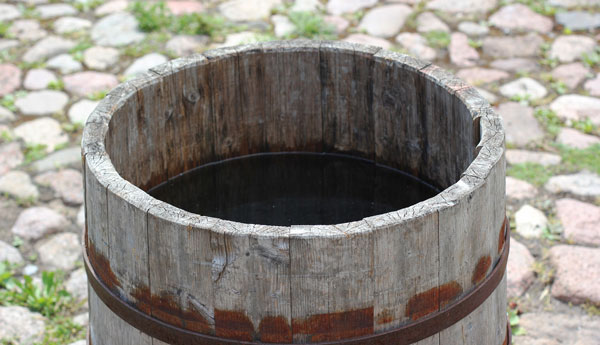
Go to almost any homestead, and you’ll see something interesting. Many of them seem to have a bit in common with a New York City apartment building–they feature a rain barrel (or three) to catch water. Now on the first glance this seems to make sense. After all, water is essential to human life, so why wouldn’t you want to capture rain? Upon further investigation though, most every homestead has its own well, and sometimes even a water source (such as a pond or stream), so why bother with a barrel, except as a backup’s backup? After all, rain is temperamental and barrels limited, compared to a well or spring. As it turns out however, much like Southerners and whiskey, plants tend to prefer their water barrel aged. Here’s why.
Picky Drinkers
But not as picky as you. Let’s get one thing clear from the getgo. Without filtration, NONE of the water you collect in your barrel will be potable. So don’t dip your head in and think “this is how grandad did it” cause, well, it’s not. Slurp from that dirty old hose all you want, but leave the rainwater alone.
Nitrogen
See, the reason you shouldn’t drink this stuff is the same reason plants should. You may notice that, after a strong rain, all your plants look a little greener–a little happier. Like most, you probably associate this with the bounty of water they have just received, but you’d actually not be quite right in thinking so. As it turns out, the air around us is about 78-percent nitrogen, and this is primarily what gives plants their green hue. When it rains, nitrogen falls to the earth in both nitrate and ammonium forms, which is immediately taken in by plants through their roots and leaves. Thus by collecting and utilizing rainwater, you are actually doing more than giving your plants water, you are nourishing them with vital nitrogen, as well.
Oxygen
Rainwater also contains far more oxygen than that water which comes out of your tap. This can help prevent overwatering, to the point that a stiff rain can even save plants overwatered with regular groundwater, by providing them extra oxygen. Next, rain brings carbon dioxide to earth, giving it an acidic pH. This helps release nutrients like zinc and iron, which are essential for plant growth.
Additive Free
Finally, if you happen to be that rare homesteader still hooked up to city water, rainwater has one final boon. City water has a small amount of chlorine in it to ensure purity and, as has been well documented on various corners of the internet, fluoride. While this is okay for humans, plants are quite susceptible to chlorine toxicity, usually resulting in burnt-looking leaf edges, or even stressed fruit. It can also carry calcium and magnesium from water pipes onto your plants, or even sodium from your water softener, which is toxic to plants in large quantities.
Sold on the benefits of rainwater? Tune in next time, when we go over some plans for DIY rain barrels, to save you the 100 or so dollars it can cost to buy one from the store.
A humble homesteader based in an undisclosed location, Lars Drecker splits his time between tending his little slice of self-sustaining heaven, and bothering his neighbors to do his work for him. This is mainly the fault of a debilitating predilection for fishing, hunting, camping and all other things outdoors. When not engaged in any of the above activities, you can normally find him broken down on the side of the road, in some piece of junk he just “fixed-up.”

Lars Drecker says
Hey yall, my apologies for the typo. As some of you have pointed out, I meant 78% nitrogen, NOT oxygen. I will be changing the mistake immediately. Thanks for pointing it out!
Murphy says
I love how know-it-alls pile on any mistake.
The author knows his subject. The 78% thing was either a hastily made oversight or someone “proofread” the article without actually READING the article.
Of course none of you geniuses have ever made a mistake.
Bob says
This is basically a bogus article. Go down to the water treatment plant in any city and see how much “stuff” gets stirred into your water AFTER it’s been drawn out of a reservoir.
I’ll take what I collect, filter and store on my property.
Grampy Tom says
With a basic error like the percentage of oxygen in air, how can I trust the author about things in the article that I don’t know.
Doug Tozier says
Relax, pretty sure that was a typo, seeing that the title of that paragraph was “Nitrogen”.
Pete Lampley says
Air does NOT contain 78% Oxygen. It contains 20.8 % Oxygen!
Brian says
You’re right. I think they meant 78% Nitrogen, the topic in the paragraph. 78% oxygen and we’d all catch on fire if someone struck a match 🙂